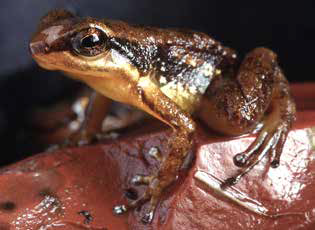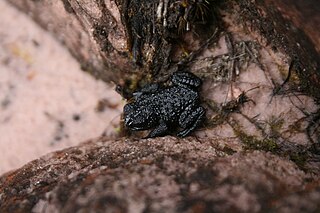
Anomaloglossus breweri is a species of frogs in the family Aromobatidae. It is only know from its type locality, Aprada-tepui in the Bolívar state of southeastern Venezuela. This species was discovered by scientists exploring the inaccessible and remote region of Aprada-tepui. It is a fast-moving frog that lives along creeks and in quiet pools along small streams along the slopes near the cave. The frog is named for Charles Brewer-Carías who collected the type series.
Myersiohyla is a genus of frogs in the family Hylidae. It was erected in 2005 following a major revision of the Hylidae and initially included four species that were previously placed in the genus Hyla. The genus is found in the tepui region of Guyana and Venezuela.

Oreophrynella nigra, or pebble toad, is a species of toad in the family Bufonidae. It is endemic to the Guiana Highlands in Bolívar State, Venezuela, and known from two tepuis, Kukenan-tepui and Yuruani-tepui, both belonging to the Eastern Tepuis.
Anomaloglossus ayarzaguenai is a species of frog in the family Aromobatidae. It is endemic to Venezuela where it is known from Cerro Jaua in Bolívar state. It is common on the top of this tepui where it is found on the margins of streams and in the surrounding forest.
Anomaloglossus murisipanensis is a species of frog in the family Aromobatidae. It is endemic to Venezuela where it is known from its type locality, the Murisipán-tepui in the Bolívar state. It is known from only one specimen collected under a rock in tropical montane forest.

Anomaloglossus roraima is a species of frog in the family Aromobatidae. It is found on the tepui of southeastern Venezuela and western Guyana; it is expected to be found in the nearby Brazil. Its type locality is Mount Roraima. It mainly inhabits large bromeliads in tepui scrub and high-tepui meadows at elevations between 1,860–2,700 m (6,100–8,860 ft) asl. The population status is thought to be rare and threatened by disturbance by tourists. The species occurs in Canaima National Park.
Anomaloglossus shrevei is a species of frog in the family Aromobatidae. It is endemic to Venezuela where it is only known from the Cerro Marahuaca and Cerro Duida, two adjacent tepuis. These frogs live near streams in tropical rainforest. It is not a common species but the population may be presently stable and is protected by Parque Nacional Duida-Marahuaca.
Minyobates steyermarki is a species of frog in the family Dendrobatidae endemic to Cerro Yapacana in southern Venezuela. It is also known by the common names of demonic poison frog, demonic poison-arrow frog, or Yapacana's little red frog. It is monotypic in the genus Minyobates.
Boana rhythmica is a species of frog in the family Hylidae. It is endemic to Venezuela and only known from its type locality, Cerro Jaua in Bolívar State. It occurs along streams on the slopes of the tepui. It is a nocturnal species found on branches of vegetation 0.3–1 m (1–3 ft) above the ground. The tepui is within the Jaua-Sarisariñama National Park, and no major threats to this species have been identified.
Myersiohyla aromatica is a species of frog in the family Hylidae endemic to Venezuela. Known only from one tepuy, Cerro Huachamacari, its natural habitats are classed as subtropical or tropical moist montane forests and rivers.
Loveridge's tree frog is a species of frogs in the family Hylidae endemic to Venezuela. Its natural habitats are subtropical or tropical moist lowland forests and rivers.
Tepuihyla luteolabris is a species of frog in the family Hylidae endemic to Venezuela where it can be found on a number of tepui. Its natural habitat is high montane tepui vegetation. Reproduction takes place in rivers.
Pristimantis marahuaka is a species of frogs in the family Craugastoridae. It is endemic to the summit of Cerro Marahuaca, a tepui in central Amazonas state, Venezuela. Its natural habitat is tepui shrubland at around 2,450 m (8,040 ft) asl where it is common in the mossy bases of Heliamphora plants.
Stefania ginesi is a species of frog in the family Hemiphractidae. It is endemic to the Chimantá Massif, Venezuela. Its natural habitats are humid rocky habitats on tepuis. While its range is restricted, it is a common species within its range. It can be found in crevices, caves, on open rock surfaces and adjacent peat bogs, in streams and rivers. Its range overlaps with the Canaima National Park.
Stefania percristata is a species of frog in the family Hemiphractidae. It is endemic to Venezuela and only known from its type locality, Cerro Jaua in Bolívar State. It occurs along streams at the top of the tepui. It is a nocturnal species found on branches of vegetation 0.3–1 m above the ground.
Stefania satelles is a species of frog in the family Hemiphractidae. It is endemic to Venezuela.

Cerro Marahuaca, also spelled Marahuaka, is a tepui in Amazonas state, Venezuela. It has an elevation of 2,832 metres (9,291 ft) above sea level and is the second-highest mountain of the entire Guayana Shield. Cerro Marahuaca shares a common base with the much larger Cerro Duida and together they form the Duida–Marahuaca Massif. Both tepuis are located entirely within the bounds of Duida–Marahuaca National Park.
Myersiohyla liliae is a species of frogs in the family Hylidae. It is endemic to the Pacaraima Mountains in Guyana and known from the region of its type locality in the Kaieteur National Park and from Imbaimadai. The species is dedicated to the daughter of its describer, Lili Kok.

Josefa Celsa Señaris is a Venezuelan herpetologist. She has published information about frogs and she has identified new genera and species. Señaris is the director of the La Salle Foundation's Natural History Museum in Caracas.

Jaua-Sarisariñama National Park was located in the Guayana Highlands, within Bolívar State of southeastern Venezuela. It was established in 1978. It has been subsumed within Caura National Park, which was established in 2017.





